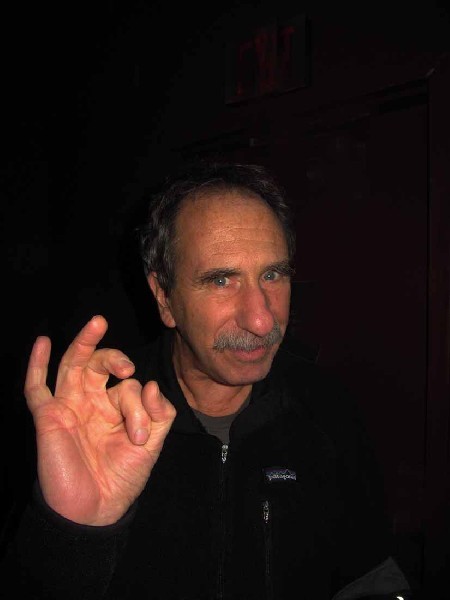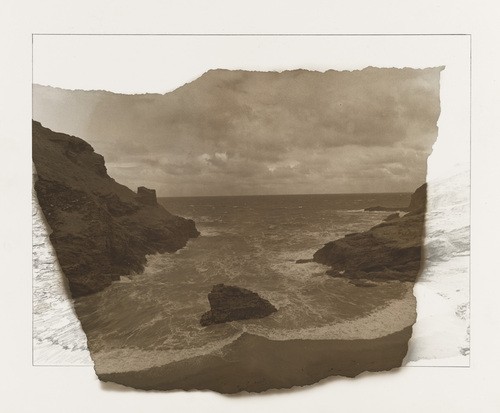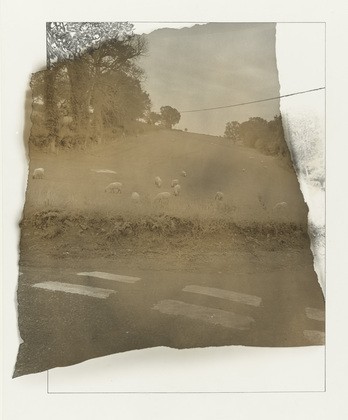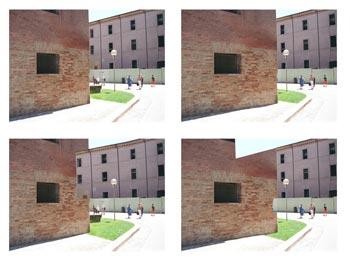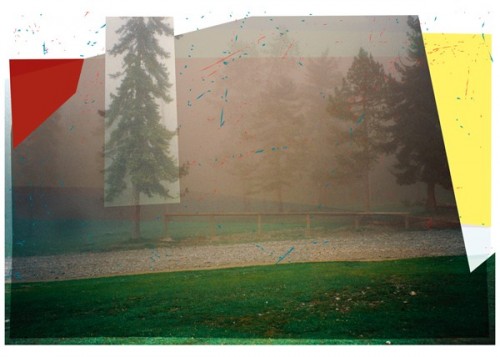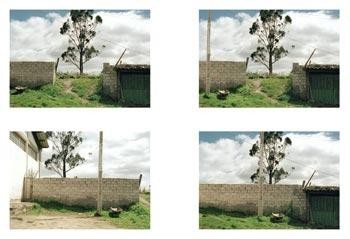Berkshire Photographer Benno Friedman
From Wet to Dry
By: Charles Giuliano - Sep 24, 2013
“If you look at an image of a rock and the shadow that it casts what happens when you remove the rock and focus on the shadow? Or remove the shadow and leave the rock,” Benno Friedman was trying to explain the essence of the digital images he has been working on for the past ten years. “Or back when we were doing wet work photography, and used to spot out the dust, the blemishes in a print, what happens if you remove everything but the dust marks? What is the integrity of the result and can you still consider that in any sense to be a photographic image? I am not so much interested in taking the image, the decisive moment, as what I can do with the image.”
In the early phase of the work in the late 1960s and 1970s, the manipulation of the print occurred in the darkroom with an alchemy of chemicals and toners that resulted in one of a kind prints. He recalls his approach with some humor as “abstract expressionist photography” using the chemicals as if they were paints.
We were seated in a cluttered office/studio on the second floor of a large old home that he has occupied since childhood in the town of Sheffield a short drive from Great Barrington in the Berkshires. They were surroundings I had not visited for the past 15 years or so. But I like, many in Benno’s extended family of hipsters, heroes and artists had know this home intimately on holidays and festive occasions during the era of the Woodstock Generation. We reconnected last summer when Astrid and I threw a summer party at our home in Adams. Benno was the first to arrive and the last to leave. And it initiated a dialogue to catch up on work which I had known and respected since we were undergraduates at Brandeis University at a time when several of its alumni made the FBI most wanted list. Including my former Chemistry lab partner. I flunked and washed out of Pre Med, thank heavens, while she went on to blow up a bank as a part of the Weather Underground in the late 1960s.
It is tempting to wax romantic about that revolutionary and experimental era- drugs, sex, and rock 'n' roll, yeah baby. Now 60 Benno, while still trim and fit, pursues a passion for extreme sports and exotic adventures. He has mellowed. A lot. And describes himself as an existentialist who is of the moment and follows the mandate to be nothing other than true to who and what he is. Right on. That also allows for glossing over a lot. The injuries and pratfalls when one insists on driving full throttle on the bumpy road of life.
With his wife Stephanie, a graphic artist, they have been together for 30 years and have two kids, Theo 12, and Nick, 17. Having lived for a long time prior to that la vida loca I asked just how you morally guide the kids through their own phase of experimentation? His answer was subtle, wise, and fiercely pragmatic. “I find myself saying things that I never thought would come out of my mouth,” he said with a wonderful laugh and shrug.
That’s particularly interesting in light of the fact that Benno was a template and focal point for an extended group of us who more or less grew up together during an amazing period in American culture. The scene as such had started with Ray and Alice Brock who lived in a former church. Famously, Arlo Guthrie wrote a song about getting busted when removing the trash after a Thanksgiving feast in the church. When Ray and Alice broke up, and Arlo moved to Washington in the Berkshires, that annual holiday celebration has been staged ever since in the house that I was visiting after a passage of some years.
At Brandeis our interaction was limited. There is a difference of four years, which then was huge. He graduated cum laude with a B.F.A in 1966. Brandeis was unique in insisting that majors in studio minor in art history and vice versa. Later over lunch in Great Barrington we agreed that the art history faculty was world class compared to a less inspiring studio program. But I was surprised when he commented on dropping out after one class in courses taught by visiting artists Jacob Lawrence and Phillip Guston. But he recalled mostly doing his own work and looking to instructors for basic information such as how to weld or make a print. Significantly, Brandeis did not teach photography until some 20 years after his graduation. So it was interesting to compare how we had both evolved to a medium for which there was no formal training.
Even as an undergraduate I found Benno to be fiercely independent to the point of eccentricity. In particular, it was challenging to have a logical conversation. He characterized this as being a part of a group of people who preferred to do something rather than just talk about it. When Alice wrote her “Cookbook” (which Benno illustrated with photographs) Ray worked on a manuscript, unpublished, with the provocative title “How to Build a Fucking House.” Many of Benno’s Berkshire based male friends worked with Ray on various construction jobs. My goombah, and Benno’s best friend, art dealer, Jim Jacobs, did just that. Built a fucking house on Mount Shango where I spent many a winter night.
A common denominator of Jim and Benno is a love of sports from skiing in Aspen, dirt bike racing, to white water rafting, or flying airplanes. I engaged in none of these activities so moved to the outer ring of association as an occasional journalist and diarist. I was wrongly accused as the author of a flagrant gossip rag piece “Alice’s Breast Flaunt” which I swear I did not write. But got blamed anyway. Lisa Condon, in particular, swore I wrote it but I am not responsible that a Playboy profile pegged her as a “bony beaked German scientist type.” There was that kind of media coverage when Arthur Penn was making the film Alice’s Restaurant. That summer, a lot of the gang worked as extras on the set. Lisa tagged him “Arthur Penn and Pencil Set.” During a drought we smoked Becka’s home grown stash. It induced dreams of fame, however fleeting. With Benno's photos I wrote a Sunday Magazine piece on the film for the former Boston Herald Traveler. Alice was on the cover.
During a time when we were all so young, gorgeous, talented and brilliant Benno’s hospitality and generosity provided the setting for an alternative life. That occurred largely through a set of circumstances that Benno describes as the corral that we find ourselves grazing in. The extent of that pasture and the limit of its fences are different for all of us. In his case, by five he lost his father and his mother passed away at 16. His legal guardian became the head master of the Stockbridge School which he attended. By college he started inviting people home for weekends and it snowballed.
“Do we have to talk about this,” he asked? Surely it is difficult but also important to an understanding of who he is as an individual, artist, and to comprehend the enormous impact he had on the lives and creativity of so many others. Including myself. “You have no choice but to be whom you are,” he responded when I stuck to the subject. “Yes, in a sense, I replaced the family. I acquired a family and friends became my family. I was lucky not to be burdened by a family I didn’t want to be around. But the downside is not to be connected to my parents and to see myself as an adult from their perspective.”
Logically, I asked to what extent that molded him. But he did not view this with such obvious determinism. He observed that another individual in the precisely same circumstance would have responded differently. Exploring the analogy of a pasture and fences he insisted that any one of many circumstances at any given time may alter the existential mandate. Things constantly change and although we remain true to a core identity the world is always in flux around us. He describes being involved with his immediate circumstances. The here and now. There is no need to hold onto the past and the many individuals who were a vivid part of it. You move on and there are different priorities. Those of us former hippies who survived and grew up, or not, have jobs, careers, families, aches and pains, failed ambitions, cling to hope, struggle on, or waste away. Whatever. Perhaps we have no ultimate responsibility other than to our immediate partners, spouses, and families. The strong focus and evolve while some falter and cling to nostalgia. Or weave tales about it which is also an art.
Just how then with wit, pluck, some resources and security enjoyed by few at an early age, did Benno find himself as a remarkable artist? Today, at 60, he is doing his best work. Although he fell off the art world radar screen a decade ago. At the peak of his career he was a successful commercial photographer, showed in the Whitney Biennial, and was represented by the most respected contemporary photography galleries of their time.
Shortly after graduation he and a girlfriend took a trip to Morocco. Friends suggested he buy a camera at a duty free shop. And, so it began. Within a year he had a portfolio to show around and started to get work. It was true to his belief that “The best teacher is just working and work comes from work. A teacher just shows you how to get something done.”
He also had his own ideas about creativity and recalled writing a paper for a psych class on the topic of “Creativity and Genius.” He recalled finding that many great creators had similar experiences. That they would achieve say 80% of their goal and then reach an impasse. “They would take a break and relax. That might be for a moment, days, weeks, months or years. Then a keystone of the project emerges. Quite suddenly it all falls into place. It is the Aha or Eureka moment. Things just happen by themselves.”
He found himself experimenting in a self taught medium and pursuing a parallel career as a fine art and commercial photographer. Earning a living as a commercial photographer supported the independence to experiment and make work that has never sold well; despite critical and curatorial success. He candidly describes himself as achieving a status “Near the top of the B list of commercial photography but not the A list.” He discussed the process by which mid career photographers start to get phased out by ever younger art directors and editors who look to collaborating with their peers. The A list photographers survive this process but the B list guys do not as a rule. He described this, with some irony, as exactly what had happened when he and his peers as emerging photographers pushed out the established Time/ Life, Conde Nast generation which had to “reinvent itself.” About a decade ago he concluded that it was not worth the struggle to hang in there for ever declining jobs.
Back then he was an outrageous emerging artist. He warmed to telling the tale of his first show at the Underground Gallery in 1969 with Don Snyder. “As you walked into the gallery we placed a number of large self portrait prints under Plexiglas. There was a narrow border around the edges. We wanted to see if people would walk over the prints to get into the space. All kinds of people went to great effort to avoid doing that. We had prints as cheap as a dollar as well as works for sale at a thousand dollars. The idea was that anyone who wanted something could afford it. We also did Dirty French Postcards which were shot off the screen in a porn theater using double exposure. There was no way to control the results which were quite interesting. Similarly, I made a series based on cowboy films. The following year I started to be in group shows at MoMA and Harold Jones asked me to join Light Gallery. I was never a big seller. When I was in the Whitney Biennial I did not understand why the gallery was not able to parlay that success into sales. But my unique one of a kind images are not easy to sell. Collectors want to acquire a familiar image from an edition. My work did not fit into any familiar mold.”
To illustrate the point he recalled showing a portfolio to John Szarkowski the curator of photography at MoMA. “His first question to me was ‘Do you have to draw outside the image,’ ” Benno recalled. “I thought it was a dumb question. His next response was ‘You don’t belong here take the portfolio to the Prints and Drawings department.’ MoMA already owned my work which had been acquired by Peter Bonnell. When I went to the curator of Prints and Drawings he said ‘Why are you here? You should take this to the Photography Department.’ That’s when I just packed up and left,”
This is a familiar story and of course much has changed in the photo world. The notion of the unique manipulated print would be less unusual. Robert Rauschenberg, for example, did a lot to expand the definitions. And curators have mounted many exhibitions devoted to the theme of this cusp between the turfs of traditional photograph and printmaking. Today few worry about staying within the margins of such limited thinking. But it precisely the efforts of Friedman and others which makes it easier for emerging artists.
When Light Gallery folded it was replaced for three to four years by Photograph Gallery. He was represented by Charles Cowles but did not sell enough to stay on. And then by Marcuse Pfeiffer which folded a decade ago. Ironically these were all among the strongest galleries in their field.
After Marcuse Pfeiffer folded “I dropped out. After a year or so I started working digitally.” That was a decade ago when he accepted an invitation to work in the lab of the School of Visual Arts. Where he continued to work two days a week. For the first five years he mastered the formidable technology while not sharing the results.
Initially, he was reluctant to abandon the darkroom and its freedom from mechanical restraints. But he came to command and appreciate the limitless possibilities of working digitally. The compete control and ability to make and store limitless variations and ultimately create editions with finite precision. Last year the S.V.A. asked him to move on. He attempted to set up a studio at home. This is where we viewed many files of completed work on the screen connected to a G-5 computer. It has been difficult to limit the distractions of daily and family life. He is planning to set up a system in the loft in the city and stick to a routine of two days a week of complete concentration. In essence, to duplicate the circumstances of working at S.V.A.
I asked if he was prepared to emerge after this ten year hiatus from the mainstream art world. The images are crisp and compelling. Ready for prime time. He showed me portfolios of the past several years, grouped chronologically. I found a remarkable continuity of ideas that observed and admired in the work since its inception. No matter how we evolve and change there is always a thread of us that remains. In his case a manner of composing and penchant for certain spaces and configurations. These observations are ephemeral but also deeply grounded. It is the way that I have always responded to the work. No matter how much we grow or shrink, eat me, drink me, we are always going in and out of the same doors of the Magic Theater.
“I think of myself as an abstract expressionist photographer" he said. "Taking the picture has been like stretching the canvas. It is not about taking the perfect image. The more perfect it is the less I can use it. This is not about the image. But freeing the elements of the image in order that they may have their own life. It’s like Chartres Cathedral. Most people will recognize it because of the different towers. But what if you switch them? Is it still recognizable? In taking something away, or changing it, is it still what it was?”
With a smile he implied that what we see and feel may not be what we think it is.
Reposted from Maverick Arts Magazine 2005

